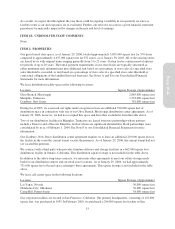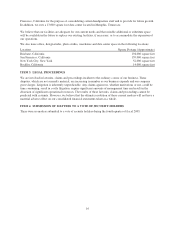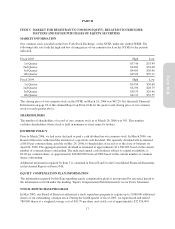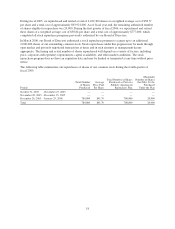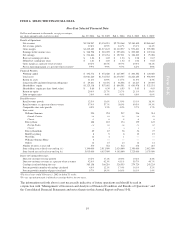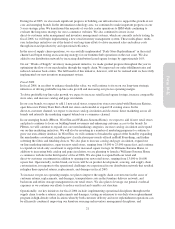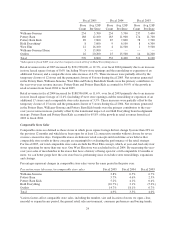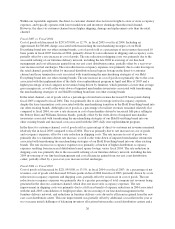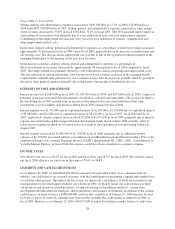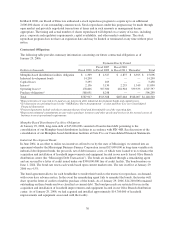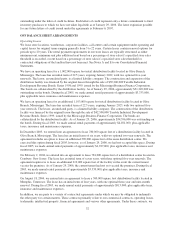Pottery Barn 2005 Annual Report Download - page 37
Download and view the complete annual report
Please find page 37 of the 2005 Pottery Barn annual report below. You can navigate through the pages in the report by either clicking on the pages listed below, or by using the keyword search tool below to find specific information within the annual report.
changes in sales mix between distribution channels, our ability to efficiently source and distribute products,
changes in our merchandise mix, competition, current local and global economic conditions, the timing of our
releases of new merchandise and promotional events, the success of marketing programs, the cannibalization of
existing store sales by our new stores, increased catalog circulation, and continued strength in our Internet
business. Among other things, weather conditions can affect comparable store sales because inclement weather
can alter consumer behavior or require us to close certain stores temporarily and thus reduce store traffic. Even if
stores are not closed, many customers may decide to avoid going to stores in bad weather. These factors have
caused our comparable store sales to fluctuate significantly in the past on an annual, quarterly and monthly basis
and, as a result, we expect that comparable store sales will continue to fluctuate in the future.
DIRECT-TO-CUSTOMER REVENUES
Dollars in thousands Fiscal 2005 Fiscal 2004 Fiscal 2003
Catalog revenues1$ 739,734 $ 764,703 $ 742,018
Internet revenues1766,306 561,249 389,967
Total direct-to-customer revenues1$1,506,040 $1,325,952 $1,131,985
Percent growth in direct-to-customer revenues 13.6% 17.1% 20.8%
Percent growth in number of catalogs circulated 4.6% 12.1% 17.4%
Percent growth in number of pages circulated 9.7% 19.5% 16.8%
1Approximately 60% of our company-wide non-gift registry Internet revenues are driven by customers who recently received
a catalog and approximately 40% are incremental to the direct-to-customer channel.
Direct-to-customer revenues in fiscal 2005 increased by $180,088,000, or 13.6%, over fiscal 2004. This increase
was primarily driven by revenues generated in the Pottery Barn, Pottery Barn Kids, West Elm and Williams-
Sonoma brands due to increased catalog and page circulation (4.6% and 9.7%, respectively) and continued
strength in our Internet business, primarily resulting from our expanded efforts associated with our electronic
direct marketing initiatives and strategic e-commerce partnerships, and the incremental net revenues generated by
the late 2004 launch of our Hold Everything e-commerce website. All of our brands in the direct-to-customer
channel delivered positive growth during the fiscal year with the exception of the Hold Everything brand.
Direct-to-customer revenues in fiscal 2004 increased by $193,967,000, or 17.1%, over fiscal 2003. This increase
was primarily driven by revenues generated in the Pottery Barn, PBteen, Pottery Barn Kids and West Elm
brands. All of our brands in the direct-to-customer channel delivered positive growth during the fiscal year with
the exception of the Chambers brand, which was retired in the second quarter of 2004 in anticipation of the
launch of the Williams-Sonoma Home brand in the third quarter of 2004.
COST OF GOODS SOLD
Dollars in thousands Fiscal 2005
%Net
Revenues Fiscal 2004
%Net
Revenues Fiscal 2003
%Net
Revenues
Total cost of goods sold $2,103,465 59.4% $1,865,786 59.5% $1,643,791 59.7%
Cost of goods sold includes cost of goods, occupancy expenses and shipping costs. Cost of goods consists of cost
of merchandise, inbound freight expenses, freight-to-store expenses and other inventory related costs such as
shrinkage, damages and replacements. Occupancy expenses consist of rent, depreciation and other occupancy
costs, including common area maintenance and utilities. Shipping costs consist of third-party delivery services
and shipping materials.
Our classification of expenses in cost of goods sold may not be comparable to other public companies, as we do
not include non-occupancy related costs associated with our distribution network in cost of goods sold. These
costs, which include distribution network employment, third-party warehouse management, and other
distribution-related administrative expenses, are recorded in selling, general and administrative expenses.
25
Form 10-K


